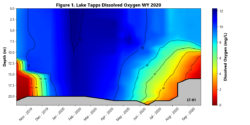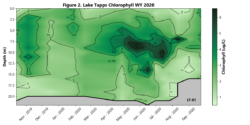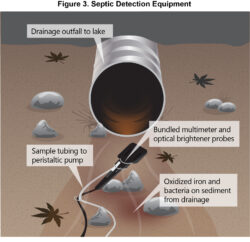Herrera Environmental Consultants is a leading Northwest engineering and scientific firm focused on water, restoration, and sustainable development. We are employee-owned, with 93 staff in five offices, and have specialized in lake management and restoration studies since 1980. We have a long history of advocating for Washington lakes and currently employ three professional limnologists as well as staff with lake monitoring, assessment, and planning experience. Herrera’s lake team has been involved in many of the significant lake water quality and aquatic plant studies in western Washington.
For example, Herrera has been providing Cascade Water Alliance with limnological consulting expertise for several years. We are now in the second year of a comprehensive baseline characterization of Lake Tapps to support current recreational uses and its future use as a water supply for the Seattle area. We have installed and are monitoring two continuously logging multimeters at the surface of the lake inlet and on an automatic profiler near the lake outlet, and are conducting twice-monthly sampling events for limnological and drinking water parameters. We accomplished this despite COVID-19 and rampant vandalism at the site.
Our first year of results showed a dramatic decrease in total phosphorus (TP) that occurs in the seven miles of canal from the White River to the lake inlet: mean summer TP decreased 86 percent from 179 to 25 µg/L. This corresponded to quite low TP concentrations of 8 and 10 µg/L in the lake epilimnion and hypolimnion, respectively. The hypolimnion TP was particularly low considering the bottom waters were anoxic in late summer (Figure 1). Summer mean chlorophyll concentrations were higher in the lake inlet (2.9 µg/L) than the epilimnion (1.9 µg/L) and hypolimnion (2.2 µg/L), while the temperature-corrected field chlorophyll profiles clearly show a metalimnetic maximum (Figure 2). Cyanobacteria represented up to 16 percent of the phytoplankton biovolume in this oligotrophic lake and were responsible for geosmin concentrations over the odor threshold but did not result in detectable cyanotoxin concentrations. These results will be used to modify reservoir operations and develop a lake management plan for reducing nutrient loading, and to help design a future water supply intake and treatment plant.
Herrera also developed an effective monitoring technique to detect septic system effluent in drainage to lakes that we have applied to Lake Tapps, Lake Whatcom, and Black Lake. We use a low-level fluorometer to detect optical brighteners in surface and groundwater discharges to the lake shores, and at suspected hot spots we test for fecal bacteria, TP, and human fecal DNA biomarkers (Bacteroidetes quantitative PCR) (Figure 3). Replicated surveys have confirmed significant septic contamination in a small portion of the tested discharges to each lake. This information has been successfully used for follow-up investigations by health departments to locate and correct septic system sources of lake pollution to these lakes.
To learn more about Herrera’s work protecting lakes and water resources in the Northwest, visit our website at https://www.herrerainc.com/ or contact Rob Zisette at rzisette@herrerainc.com or 206-787-8262.













